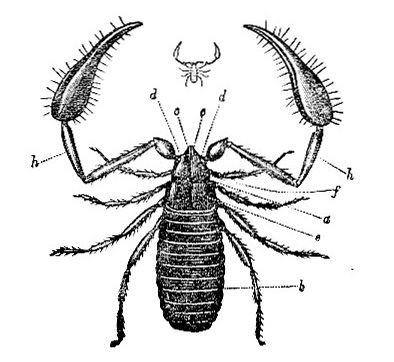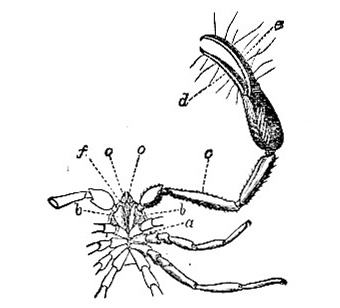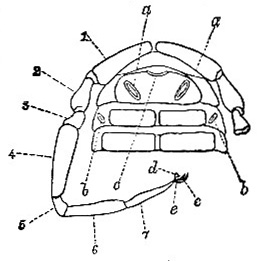(16) ARACHNIDA - ORDER V: SCORPIONIDEA - SUB-ORDER I: PSEUDO-SCORPIONES - EXTERNAL & INTERNAL STRUCTURE; GENERAL OBSERVATIONS
External Structure: These are distinguished from the Scorpiones chiefly by the absence of a tail and by their mode of respiration (figs. 16, 17, 18). The body is of an oblong-oval form; the cephalo-thorax is coriaceous; the abdomen sessile and, generally, composed above of eleven, underneath of ten segmented rings or articulations, usually covered above and below with a double longitudinal series of transverse corneous plates, united laterally by a membrane, the folds of which correspond to the transverse plates. In the second sub-abdominal segmental plate, on each side of the median line, there is (in some species) a small spiracular opening, and in the lateral connecting membrane of the third segment, opposite to the end of the third sub-abdominal plate, on either side, is another similar opening. These four stigmata are the external apertures to the tracheary system (fig. 18); behind and between the two first mentioned stigmata is a spinning organ, furnished with minute tubes for the emission of the silken threads; and close to this spinner, at the fore margin of the first abdominal segment, is the genital aperture.

Fig. 16 -- Chelifer sesamoides, Savigny. a, cephalo-thorax; b, abdomen; c, c, falces; d, d, eyes; e, hinder segment of cephalo-thorax; f, front ditto; h, h, palpi.

Fig. 17 -- The same: portion of under side. a, rudimentary sternum; b, b, maxillae; c, palpus; d, digital joint; e, movable fang; f, labium; o, o, falces.

Fig. 18 -- Chelifer cancroides, Linn.; portion of under side. a, a, b, b, orifices of the respiratory organs; c, genital aperture; d, sucker-like tarsal claw; e, e, superior tarsal claws.
The legs are closely affixed by the coxal joints to the lower side of the cephalo-thorax, and sit closely to each other, having a very small longitudinal space between them analogous to a sternal plate, of which, however, there is not even a rudimentary one, properly so-called. The number of joints in the legs is seven (Menge), but there appears to be a variation in this respect in some species. Each tarsus ends with two curved finger-like claws terminating with a short nail, and beneath them is another claw, modified at its extremity, gradually enlarging into a kind of conical form, probably acting as a sucker for the purpose of adhesion to smooth objects (fig. 18, d). The tarsal claws spring from a small heel or claw-joint.
The palpi are five- jointed, long and strong, terminating with a digital joint of large size, more or less bulbous at its base, and drawn out at its extremity into a jaw-like claw, furnished with hairs and bristles, and generally serrated along its inner edge. Against this claw another, articulated to the extremity of the bulbous portion, acts in opposition like the pincers of a crab. Supporting the palpi on either side are the maxillae, forming the lower side of the mouth, the upper side being formed by two didactyle falces; besides the movable jaw of the falces, there are connected with them some denticulate spines, or other spiny processes and bristles. Within the mouth is a tongue, which also serves as a sternal labium, and differs in its form in different species. The eyes, two or four in number, are situated on each side of the fore part of the cephalo-thorax, but there are none in the medial line. In some instances eyes are wanting altogether.
With regard to internal structure, the Pseudo-Scorpiones are very similar in their muscular system to the spiders (Araneidea) (Menge). The digestive apparatus is simple; a large stomachal pouch contracted a little in the middle lies in the thoracic cavity, and from it the alimentary canal runs through to the hinder extremity of the abdomen, with a double crook in the course of its passage; this canal is embedded on all sides in a mass of substance serving the function of a liver. The external spinning organs have already been mentioned; the internal apparatus resembles that of spiders, consisting of a number of small elongated pear-shaped sacs, communicating outwardly with the spinning tubes.
Nothing certain appears to have been discovered in regard to the circulatory system of the pseudo-scorpiones, except that a simple vessel runs along beneath the middle of the abomdinal ridge; the vital fluid being found free among all the other organs of the body, so that the air is conveyed to the blood by numerous air-tubes, and not the blood to the air.
The tracheal character of the respiratory system has been just mentioned. The spiracular openings vary in number in different species, two or four. From the two hindermost of the abdominal apertures, when four are present, there issue more or less numerous thread-like tubes, which convey the air to the different parts of the abdomen. From each of the two foremost stigmata a main tube runs obliquely through the thoracic region, and from this tube finer ones issue to the rest of the cephalo-thorax and its adjacent parts-legs, palpi, and falces. When two spiracular openings only are present a large tube runs from each forwards into the thorax, and finer ones backwards into the abdominal parts.
The reproductive organs are simple. The external parts in both sexes are situated in the second (?) segment beneath the fore part of the abdomen, and consist of two small oval openings close together. Into each of these there opens in the male a curved horn-like sac, with a lateral direction as well as a smaller longitudinal duct, the latter leading form a common seminal receptable. In the female a two-branched oviduct leads from the ovaria into the external apertures; the mode of reproduction is oviparous, and the eggs are carried by the female beneath the fore part of the abdomen, somewhat like those of certain of the Araneidea.
GENERAL OBSERVATIONS. - The Psuedo-Scorpions are all of very small size; they do not appear to form more than one family group, Pseudo-Scorpionides, of which several genera and numerous species have been described by various authors. They are widely distributed, being found in tropical as well as in temperate climates. Europe possesses many species, and even England has several - these being the sole representatives of the Scorpionidea in this more northern latitude. Their habitat is under stones, beneath the decaying bark of trees, on the damp soil, among moss and herbage; some are found amongst old papers in houses, and in herbaria, and others are said to be parasitic on the common house-fly. For more minute details of structure and other particulars, see A. Menge, Ueber die Scheerespinnen, Chernetidoe, who separates them from the scorpions under the above name, as a family group, more nearly allied by their internal structure to the true spiders than to the former. Menge gives also a list of works on this sub-order. A paper lately published by Dr Ludwig Koch, at Nuremberg, 1873, pp.68 describes and gives analytical tables of all the European genera and species at present known.
Read the rest of this article:
Arachnida - Table of Contents
|


